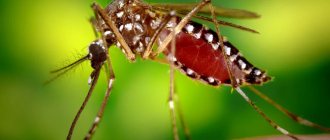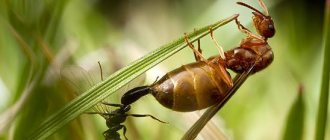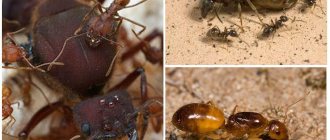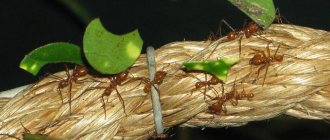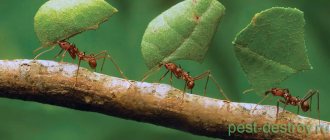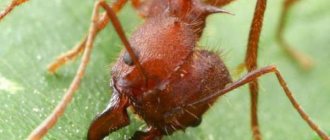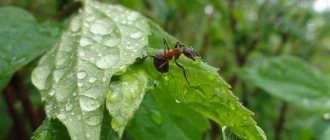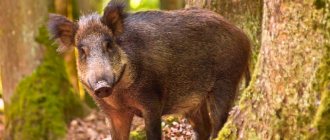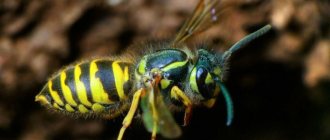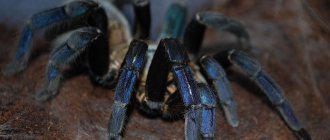19.02.2016
Often, watching ants swarming in a forest or in a clearing, many people have a question: how many years do these workers live, what affects the quality and duration of their life? Are there effective ways to control these insects if you suddenly find them living in your neighborhood?
- Lifespan of ants by species
- Red forest ant
- meadow ant
- Pharaoh ant
- Black garden
- What determines the lifespan of ants?
Life cycle of ants
What do ants look like?
The body of an ant (in Latin - Formicidae) consists of three sections: head, chest and abdomen.
All parts of the body are connected to each other by elastic bridges, which makes the ants very flexible, mobile and resourceful. There are three pairs of limbs on the chest. The head is usually large and equipped with powerful mandibles, necessary for grinding food, holding food, or generally for defense. The life cycle of an ant includes the following stages: egg, larva, pupa and adult. It is at the larval stage that the diet of the larva determines who will be born: the queen, infertile females, males, or just worker ants. This entire process takes from 1 to 2 months.
Ant social classes
From a social point of view, ants (house and garden ants, including) are very organized insects. The population of any anthill is divided into castes:
- Uterus. The most important link is the queen (queen mother). It performs the most important function - it reproduces offspring. In a small anthill there may be one queen, in large ones there may be several. The queen mates once in her life. All the time he spends his time creating new ants. The resulting sperm are enough for her entire life cycle. This is where the queen’s interaction with the rest of the anthill practically ends.
- Males. Created only for reproductive function. After its successful implementation, they usually die.
- Workers. Most of the ant colony are underdeveloped females. They are unable to reproduce. Their main task is work. These are the worker ants that ensure the life of the anthill.
- Soldiers. Soldier ants perform a protective function and can also attack other colonies. These individuals are usually larger than others and more aggressive. It is a known fact that in some species soldier ants cannot feed on their own; worker ants feed them.
How many years does an ant live?
The life span of ants depends on what species and what caste it belongs to. From birth, the caste of the insect is determined and it does not change throughout its life. Worker ants, queens and males live in one family.
However, not all species of these insects exhibit a strict division into castes. Individuals of black garden and pharaoh ants can change their “specialization” throughout their lives. A newborn ant can take care of larvae and eggs, later - set up a home, and at the end of life - get food.
In addition, the length of an insect's life cycle is affected by its size. It has been noticed that the larger the ant, the more likely it is to live a longer life. The conditions of its life also play a significant role in determining how long an ant will live.
Description and features
An ant is a representative of the class of insects, the type of arthropods and the family of ants. These insects live in huge colonies with a clearly defined hierarchy, including division into three groups:
- Uterus
- Males
- Worker ants
Their body consists of a head, torso, three pairs of limbs and antennae, sensitive to external environmental factors, aromas and air currents; in fact, they perform the function of tactile organs. The feet have hooks for easy grip on the surface.
Body size varies from 0.4 to 1.3 cm depending on the species. The queen is usually the largest individual, but may be equal to other members of the community. The color also depends on the variety: red, black, green, etc.
But the presence of wings on the uterus, which die off after the end of the mating period, is found in almost all varieties; some have wings, regardless of gender and place in the community.
The insect has five eyes: two central ones with numerous lenses transmit a blurred image, but allow movement to be recorded; three additional ones have a primitive structure and are located on the top of the head.
The main reference point for ants is smell: with its help they identify members of their community and find food. Special smells are intended to warn of danger and call for help.
To protect against enemies, insects have a sharp sting on their abdomen, with which they can cause serious harm; at the same time, special glands secrete a toxic substance containing a high concentration of acid.
For a person who does not suffer from allergies, it is not dangerous in small quantities; usually the bite site simply turns red and itches. For insects and small animals, the poison poses a mortal threat and can cause severe intoxication.
Life depending on gender
Most of the anthill consists of workers - unfertilized females. Such ants live in nature for about a year, although theoretically they can live up to 3 years. This duration is typical for small representatives of our area - pharaonic, black garden, red. The lifespan of larger varieties is somewhat longer. Red forest animals live up to 3 years.
Interesting!
The lifespan of a male ant is much shorter - from 3 months to several weeks. Directly depends on participation in the mating season. After mating, the life of males begins to be counted in days. In 10 days he will die.
The fertile female lives the longest - the queen, the queen of the ant family. For different species, experts give numbers from 5 years to 25. The head of the family does not appear outside, since there is no need for this. Once fertilized, she continues to lay eggs throughout her life. She is looked after properly and fed in the best possible way.
What ants live near humans?
Several species of ants coexist with people.
Garden pests:
- Meadow. Small red-colored insects. Sizes vary from 6 to 12 mm. They build loose anthills with a diameter of about 3 m.
- Garden. Individuals are black/dark brown. The length of the body in males is 4–5 mm, in females - 1 cm. The main floors of housing are located underground, with a poorly visible hill on top. They can settle in tree trunks, under stones, etc.
- Forest. Distributed throughout the forests of central Russia. Large (7–15 mm) representatives of the ant genus of a dark red (almost brown) color. They build tall houses from small plant debris and branches.
The pharaoh ant most often visits a person’s home. Hence its other name - Brownie. The insect is usually red in color, 2–4 mm in length. There are also individuals of brown-yellow color. Males have wings.
Life depending on your “profession”
Life and reproduction of ants
The ant family is characterized by a clear division into castes; there are more than 10 professions. How many years ants live depends on their type of activity. The longest living individuals are those caring for the queen, cubs, larvae, and performing work inside the nest. They easily live up to the age of 3 years, sometimes 5.
Individuals that are in constant search for food, are engaged in external construction of the house, are exposed to many dangers every day, and therefore risk their lives very often. Their lifespan barely reaches a year. Domestic ants also die from the action of poison, poison offered by humans.
On a note!
How many ants are in an anthill can be approximately determined by the size of their housing. Several million individuals live in a house about 1.5 m high. Below there are 2 times more passages than above the soil surface. The colony loses several hundred individuals every month, and at the same time replenishes the family with new members of society in the same number without damage to the total number.
The benefits and harms of ants
The benefits and harm from insects depend on how large their family is and where they live: on a personal plot or in a forest. Garden ants contribute to the enrichment of the soil with oxygen, as they dig their tunnels in the upper layers of the soil.
Humus and remains of organic waste carried by ants into their homes decompose over time, saturating the soil with minerals and making it more fertile. Insects are also plant pollinators: while obtaining nectar for food, they transfer pollen on their abdomens.
Unfortunately, ants contribute to the proliferation of aphids, since they feed on the products of their vital activity, therefore, where there are many of these insects, aphids also live freely, causing enormous damage to the crop.
At the same time, they are capable of exterminating caterpillars and some types of butterfly pests. If ants appear in a human home, they not only cause discomfort, but also eat food, spreading infections and causing allergic reactions.
Forest ants protect trees from parasites, destroying huge populations of them. In addition, by collecting the secretions of certain insects, they protect plants from fungal diseases. But the woodborer is capable of destroying a healthy tree in just a few weeks, making tunnels in its trunk.
This species is also dangerous for garden furniture made of solid wood, since neither paint coating nor pungent-smelling products for treating wood products can scare them away.
Ants secrete a special secretion called formic acid; it is widely used in medicine and pharmacology, and is included in antiseptics, drugs to combat the development of diabetes, arthritis, etc.
If the acid enters the human body in its pure form, it can cause severe anaphylactic shock, which, without timely administration of antihistamines, leads to death.
Lifespan of different types of ants
According to the species, there are differences regarding the lifespan of an ant; there are several factors that influence this; let’s consider the main ones.
Red Forest - Formica rufa
This type of insect is also called a mixed forest orderly, since the inhabitants of a large anthill have the opportunity to cleanse an entire hectare of forest from pests of all types. Throughout the day, hard workers are able to collect several thousand pest pupae, which are then used as complementary food for the larvae.
Speaking about the life expectancy of red forest ants, according to genetic factors, it is limited to five years, but in life they die much earlier than nature gives them. The reason for this is that they turn into prey for birds.
It is also worth noting that the males even die a month after completing their main function. The female has the opportunity to become a long-liver if she constantly stays in the anthill.
Meadow - Formica pratensis/Messor Structor
This species is also called reapers; they prefer meadows and forest edges as their habitat. Females leave their place of residence only twice in one season, the purpose of which is fertilization. Speaking of life expectancy, it coincides with the previous type of insect.
Ants that rarely leave the comfort of their anthill have a longer life span compared to those that are forced to do so often. This is why working individuals die faster; the main cause of death is an attack by a predator, as well as a high risk of injury.
Pharaonic - Monomorium pharaonis
The pharaoh ant is one of the main domestic pests that was introduced from hot habitats. He moves in and lives in the house. Inside apartments, this species does not build an anthill, but chooses a separate cavity or niche as a home.
If pharaonic individuals settle in apartment buildings, their colony can reach several thousand representatives, each of them belonging to the same family.
This type of insect is characterized by the shortest life cycle. The female can live on average no more than nine months, breeding males only 20 days, and the worker caste no more than two months.
But despite this, over such a short period of existence, ants are able to reproduce at least 30 thousand individuals - this is done due to the fact that the nest of the family includes a large number of queens.
Tropical - Myrmecia gulosa
Tropical ants are considered long-lived among all species, here the life limit is not 6, or even 10 years, the queen can live up to the age of 20-22 years, if we talk about working individuals, then they live less, but also quite a lot - about five years .
According to entomologists, the average life cycle is:
- Working caste - 1-3 years; It is worth noting here that large individuals will live much longer than small ones; In addition, climate is an important factor - in cold regions, inhabitants will die earlier than they gather in the tropics;
- Males are limited to a cycle of several weeks. Their main goal in life is to take part in mating, after which they are destroyed by individuals of their own anthill, and they can also become prey for predatory animals. Rarely, there are cases when males are left alive - this is only possible if there are several queens in the anthill;
- The queen can live for 20 years, this figure exceeds the average age of ordinary working ants by ten times. During such a period, one queen can provide offspring, the number of which reaches half a million individuals.
What determines the lifespan of ants?
To summarize, it can be noted that the life of any ant depends on such important factors as:
If any anthill is left without a queen, its lifespan is significantly shortened. In this case, the hierarchy of the colony is severely violated, and the meaning of its existence as a whole is lost. Even if other ants are capable of leaving offspring, such an anthill will not be viable and is unlikely to last long.
Source
How many years do ants live in the wild?
“In the wild,” the lifespan of an insect can be either annoyingly short or quite long. After all, ants have natural enemies who reduce their population either with the aim of capturing the territory controlled by the anthill, or with the desire to eat delicious insects.
And if we do not take into account natural enemies, then the actual life expectancy of ants depends only on the individual’s belonging to one of the three castes of this family of insects, of which, as is known, there are as many as three in this family - workers, queens (females) and males.
As a result, the following picture emerges:
- A worker ant lives from 2 to 24 months . Moreover, it is the northern ants that live the longest, hibernating for 9 months during each year of their life. Insects from the tropics, as well as the southern regions, live the shortest lives, aging in 2-3 months. That is, all “soldiers”, “foragers”, “nannies”, “builders”, “cleaners” and other individuals not associated with the insect’s conception cycle live no more than two years, and this is even in the best case.
- The queens of anthills - queens - live from 3-5 to 15-20 years . Moreover, how long the ant queen lives depends only on whether the insect belongs to a specific species of a given family. However, the northern “queens” of the 180 species “native” to Europe always live much longer than their southern colleagues from Asia (2080 species) and Africa (2500 species). Moreover, during its long life, each queen is capable of “generating” more than half a million working individuals.
- Males of European, Asian and African ant species live no more than 2-3 months . Moreover, after mating with the queen, the male’s lifespan is calculated not in months, but in days - he dies in 8-10 days.
However, the lifespan of one individual has practically no effect on the very existence of the colony. The queen can give birth to the next female, and the anthill will continue to exist indefinitely.
How long do house ants live?
Insects living in houses and apartments are in more privileged conditions than their forest and field counterparts. After all, they have access to an extensive coma database and live in almost ideal climatic conditions - constantly above-zero temperatures, lack of rain, and so on.
However, despite the favorable living conditions, the lifespan of a domestic insect is much shorter than that of a forest ant.
After all, almost all “domestic residents” belong to the species of pharaoh ants, which are characterized by the following duration of existence:
- Working individual – 60 days.
- Male - 20 days.
- Female - about 300 days.
Moreover, the development period of any individual - from egg to insect - is 38-42 days. As a result, if you poison only working individuals and leave at least one queen alive, then in 1.5-2 months new hordes of insects will crawl around your apartment. And vice versa: if you kill the queen, you will destroy the anthill. After all, how long does a house ant live without a queen? That's right - 20-60 days, and no more.
Review: We fought with the ants for a long time, but it all ended after we managed to find their nest and destroy it. We poured boiling water over the main ant pile and all the insects disappeared from the house within 2-3 weeks. Therefore, do not listen to anyone and do not buy anything - go straight to their lair. Otherwise you won’t be able to defeat them. Sergei Semenovich, Kazan.
How to reduce your home ant population?
To combat ants at the household level, it is customary to use two extermination techniques:
- Liquidation of food supply
- Elimination of the insects themselves
Impeding access to food will lead to a guaranteed reduction in the population. The ants will not be able to service the larvae, so most of the colony will not transition from the egg stage to the pupa or adult state. Moreover, in this case it does not matter at all: how many ants live in the anthill - the population will suffer in any case. After all, a large concentration of insects needs an extensive food supply.
How to reduce this base? Yes, very simple:
- Wash your plates immediately after eating.
- Eat your meals in one place.
- Take out the trash can once a day.
- Do wet cleaning as often as possible.
- Do not keep food in sight - there is a bread bin for bread, and a cupboard or cupboard for sugar, jam, honey or sweets.
All these precautions, of course, require some physical effort and concentration. After all, these rules will have to be followed around the clock throughout your life.
Review: I don’t have ants, and never have. I always hide sugar in a sugar bowl and wash jars of jam or honey. And I always spray the inside of the trash can with anti-ant aerosol. But the most important thing is that we only eat in the kitchen. My mother taught me to wash the floors at least every other day. Therefore, there are no ants or cockroaches in my house, which cannot be said about my neighbors. Galina Vasilievna, Stavropol.
Physical elimination of insects is a fairly effective method of combating ants. However, the results of this method depend on the “depth” of processing of the apartment or house. After all, if you destroy only the working individuals scurrying around the room, the queen will restore the population in a maximum of 1.5 months.
Therefore, when choosing a poison for ants, pay attention not to instant-acting preparations, but to products with a “surprise” - gels or homemade baits transported to the anthill by foragers. A poison with a delayed period of action affects not the individual who found the bait, but all the inhabitants of the anthill. Including the uterus.
However, the fight against a colony using such a “surprise” tool will last for 2-3 weeks, during which you will have to update “traps” and “mines” throughout the apartment. And this is a very troublesome task.
Therefore, connoisseurs of their time prefer to contact SES or special companies. After all, professionals use special preparations and special devices with which you can defeat any colony of ants in literally one “combat operation”, completed in 1.5-2 hours of working time.
At the same time, the cost of the work of SES or specialized companies practically does not exceed the cost of purchasing truly effective drugs against ants. For example, for a one-room apartment they charge no more than 1,500 rubles.
Lifestyle and habitat
Due to the large number of species, the life of ants influences biogenesis. By creating anthills, they actively loosen the soil, saturating the roots of plants with air and moisture. Inside houses there is a warm and humid atmosphere in which bacteria actively multiply, processing waste products and excrement. Thus, insects help saturate the soil with nutrients.
The ant is a social insect, the structure of their communities is similar to that of humans, characterized by a clear structure in which the distribution of roles plays a vital role. Some species, in addition to the three main castes, have an additional one - soldiers, they serve as protectors of the anthill, for this the workers provide them with food.
A special variety of insects, fire ants , subjugate representatives of weaker families and parasitize at their expense. In any case, the anthill is a single organism, without which individual individuals cannot survive.
Ants have settled across all continents and climatic zones with the exception of deserts, Antarctica and the cold islands of the Atlantic and Arctic oceans. Each species has its own habitat, but ants are able to move even between countries and continents, forming new colonies where they were not previously settled.
At the same time, stronger varieties are able to displace weaker ones from their usual places. Life in a warm climate allows insects to reach impressive sizes for the family and continue their life activities year-round; ants in temperate and cold zones are much smaller and hibernate in the winter.
Most species organize their homes in the form of anthills; these can be earthen dwellings, settlements in tree bark or rotten stumps; special species are able to capture bird nests and settle in them.
Caste
An ant family is a well-coordinated team, each member of which contributes to the overall well-being. The number of individuals in an ant colony is related to the variety of these insects. One family can consist of several dozen individuals or several million “relatives”.
As in any society or group, there is a kind of hierarchy in ant colonies. In ants, it is expressed through the division of individuals into castes, which determine their purpose. According to castes, ants are divided into:
- workers;
- males;
- queens (females).
Representatives of these three castes live in each ant family. Living together in one home, insects perform their prescribed duties throughout their lives. The belonging of an individual to a specific caste is determined from the moment of birth, and it is impossible to change it subsequently.
Ants have one of the most complex social systems in the animal world; caste determines the type of activity of an individual
The worker caste is divided into subcastes - soldiers, builders, foragers (or food earners), "nannies", etc. In most subspecies, individuals are assigned to a specific sub-caste and “work” in one area of activity all their lives. But some species of ants do not have a clear distribution among subcastes.
For example, representatives of the black garden species, as well as pharaoh ants, are capable of repeatedly changing their “profession” throughout their lives, that is, moving from one subcaste to another. An approximate scenario of how this movement might occur:
- Newborns take care of eggs and larvae.
- Having matured, they are engaged in arranging the family home - an anthill.
- With the onset of “old age,” ants search for and obtain food.
The relationship between “specialty” and life cycle
It is the worker ant individuals that people most often encounter. Insects of this caste are unable to fly or reproduce, despite the fact that they are not asexual. Workers are females that never become queens. They only build, protect the home and other individuals, take care of the nest, create comfort and get food.
Representatives of the worker caste live on average from 1 to 3 years. Although science also knows individuals that stand out from the statistical data. For example, pharaoh ant workers live for approximately two months, while bulldog ant workers can reach five years of age.
The lifespan of a worker ant ranges from 1 to 3 years. They are the ones who build and provide the anthill with food.
In working individuals, the effect of size on life expectancy is especially noticeable. Small worker ants live much shorter lives than large ones. Another important factor is the environment. As already noted, inhabitants of regions with cold climates, according to scientists, usually live longer than individuals from tropical areas.
Representatives of the soldier subcaste are predisposed to longer lifespan than other workers. But in fact, they live much less, like any other individuals, who are often forced to leave their homes. Insects leaving the anthill very rarely live out their genetically determined lifespan. Much earlier they die from competing ants or insectivorous predators. Quite a few of them were killed under people’s shoes, not to mention the wheels of cars.
Soldier ants play a protective role in the anthill; genetically they should live longer than workers, but in fact they die faster
It is precisely because of the high mortality rate of ants that come out that they become foragers already at the last stage of existence, that is, when the life cycle enters the final stage, and the individual will soon die in any case.
Ants that spend their entire “life” at home successfully live to the physiological limit. In the nests created by worker ants, representatives of two other castes - males and females - gather every year before the mating flight. Both the first and second can fly and reproduce. They mate in the air.
Participation in the mating process is the main task of males and the only benefit they bring to their family. After fulfilling their assignment, they are overtaken by death - either they are killed by workers as there is no further need, or they die from birds or other insectivores. Therefore, male ants have the shortest eyelid of all individuals - their existence lasts only a few weeks. In certain varieties of ants, the elimination of males is not part of the mandatory program, but only if there are several queens in the anthill.
The queen ant lives longer than other castes. The main task is the production of offspring
After mating, females face a completely different fate than males. They turn into queens - producers of offspring. Ant queens are record holders for longevity. No individual can live as many years as the ants of the queen caste live, no matter what size it is and no matter what favorable conditions it lives in.
The life cycle of the uterus can reach twenty years (maximum). This is 10, or even more, times longer than the lifespan of a working individual. Having given birth to many new individuals, the queens go to “retirement” - they shed their wings and choose an anthill for their permanent residence. Over the course of her life, the queen can leave offspring numbering up to half a million individuals.
It is worth noting that twenty years of age is still not the limit for the uterus. An officially registered case of a queen of carpenter ants reaching the 28-year mark. Moreover, the age was calculated without taking into account the larval stage. This is a record that has not yet been broken.
Types of ants and their lives
The belonging of insects to a certain species is inextricably linked with all the features of their existence, including its duration. As vivid and interesting examples of different lifestyles, we can consider the following representatives of the ant people:
- red forest ones;
- pharaonic;
- tropical (including bulldogs).
The maximum lifespan of a forest ant is five years.
The lifespan of an ant of this species, as intended by nature, is limited to five years of age. But in reality, they do not live to see this period and die much earlier. The main reason for the early mortality of these ants is the birds that feed on them. Males, as expected, complete their life cycle a maximum of a month after mating. And the queen has every chance of outliving all the inhabitants of the anthill, but only if she stays at home all the time.
https://www.youtube.com/watch?v=5rE4tLhP5dM
These small two-millimeter creatures, which came from hot countries, do not build anthills or other buildings themselves. They chose people's houses and apartments as their habitat. They usually settle in separate niches and cavities. Having settled in an apartment building, one family of pharaonic ants is able to multiply into a colony of many thousands.
Of all the varieties of ants, pharaoh ants have the shortest life cycle. Insect workers usually live no longer than 2 months, males - about 20 days, queens - within 9 months. However, their short lifespan does not prevent these ants from actively reproducing. During their existence, pharaoh ants produce over 30,000 new individuals. Such high productivity is due to the presence of a large number of queens in one nest.
Despite the longevity record set by a representative of the carpenter species, the champion title for life expectancy was awarded to tropical ants. The maximum age of individuals of this species reaches 22 years. Of course, this applies to queens, and only those of them who are constantly in the anthill.
One of the largest ants in size. Tropical Bulldogs can live up to 22 years
Representatives of tropical ants are very impressive in size; they are among the largest ants in the whole world. Giants from the worker caste can live 5 years, and queens can live about 20 years. This is the most striking example of how the size of an insect and its lifespan are related.
What do ants and bees have in common?
The closest relatives of ants are bees and wasps. All of them belong to the order Hymenoptera
There is one single important difference: ants are 100% social insects, unlike bees, which are solitary. The lifespan of a bee is many times shorter than that of an ant.
The commonality between an anthill and a hive lies in their social hierarchy - both have a Queen or a Queen, males - bees call them drones, and many working individuals - who provide the vital functions of all other inhabitants.
_____________________________________________________________________________
What do harvester ants eat?
Particular attention should be paid to the feeding and extraction of food by the reapers. Since they most often feed on grain crops, ants were long thought to be agricultural pests. However, research has shown that insects only harvest crops that directly fall to the ground.
Reserves
The gathering of provisions is very interesting among the reapers. As stated earlier, the harvesting of grain occurs when it is on the ground.
The workforce collects about 1.5 kg of grain crops from the fields in one season
Scientists have found that harvester ants send out workers as much as there is available food. If there is a lot of it, then the workers return faster and the number of ants sent for food increases. But if they return slowly, then the number of ants sent out decreases or stops altogether.
To store grain, hardworking reapers set up special rooms deep underground. In damp, warm rooms, the seeds begin to germinate, and as soon as the first sprouts and roots appear, the ants immediately destroy the shoots. After this, large soldier ants grind the grain into powder with their powerful jaws and, moistening it with saliva, feed this mixture to the larvae.
How do ants appear in gardens and houses?
Domestic parasites come from the street. First, ants start in basements or garbage disposals, then they penetrate directly into the house. Here you can always find some leftover food, crumbs, and pet food. Insects create a nest very quickly and it is extremely difficult to find it.
They get into vegetable gardens from nearby forest areas or from turf soil. Migrating colonies become residents in dacha areas. Another pest, aphids, will help make them stay for a long time.
How is an anthill organized?
Up to 5 thousand individuals can live in an anthill.
There is a strict hierarchy in the colony of harvester ants: each family member is busy with his own business. The family consists of a queen - she produces offspring, soldiers - they protect the anthill from dangers and help with harvesting, worker ants - they are engaged in obtaining food and caring for the young. There are also males and females - they mate with each other, creating new colonies.
From the outside, the anthill's shape resembles a volcano
The ground part of the ants' home is a hole in the soil, along the edges of which there is a shaft of earth and debris from the prey they bring. The underground part has a vertical tunnel, from which passages with cameras extend on the sides. In these rooms, ants set up pantries for storing food and “children’s rooms” in which they store larvae.
How to keep harvester ants at home
Nowadays, many people, as a hobby, start so-called ant farms, which are transparent boxes made of plastic or glass. Inside them there is an imitation of an anthill - numerous passages and chambers.
Thanks to the transparency of the walls, it is possible to study the life of insects in detail.
Purchasing an anthill - what kinds of anthills there are, their cost
A home anthill, or formicarium, looks like an aquarium or a display case with filler inside. There are simple and complex systems in which a climate favorable for the life and reproduction of ants is automatically created and maintained: lighting, humidity and temperature. There are different sizes - from small tabletop farms to bulky anthills for the living room or office. Various fillers are used for formicaria: gel, gypsum or a mixture of soil and sand.
The so-called “Cubus” and “Colosseum” models are shaped like a cylinder, cube or double-walled display. The space between them is filled with multi-colored sand, in which the ant colony builds passages and chambers. The cost of such structures is high - from 3 thousand rubles, but the kits include food for ants, sand and other additions.
Formicarium brand "Colosseum"
An anthill with a gel filler is similar to an aquarium, but is filled not with water, but with a transparent gel. Such a house for reapers does not require careful maintenance, but once every 5–7 days the lid of the aquarium must be opened for a couple of minutes for ventilation. The price of such formicariums is low - from 500 rubles.
This filler is safe for people and insects - it is both a habitat and a breeding ground for ants
A plaster truss is affordable in price (from 700 rubles). This is the most popular type of domestic anthill. The surface of the gypsum is often painted in bright colors, which makes formicariums a stylish and unusual addition to any interior.
The plaster model is perfect for children and beginners in ant breeding.
Ant houses can be purchased in specialized online stores. The catalogs contain farms of various models and sizes. As a rule, pet stores do not sell ant farms.
Making a formicarium yourself
If you are not attracted by prices in stores, then there is the opportunity to make a formicarium with your own hands. For the base, you can take two jars with transparent walls - a large and a small one - and then fill the space between them with the selected material. It can be a mixture of soil and sand, gypsum or gel.
Choose a large jar with a wide mouth to make it easier to fit smaller jars.
Soil-sand farm
To begin, prepare a mixture of one part sand and two parts soil. Make sure that the composition is slightly damp - it will be easier for ants to break through passages and chambers. The mixture will be needed so much that the space between the jars is filled 1.5 cm from the edge of the vessels. Make small holes in the lid for air circulation.
Gel farm
Making such a farm yourself will be interesting for both adults and children. To do this, you will need gelatin and a flat container with a lid and transparent walls.
Pour three 15 gram bags of gelatin into 0.5 liters of hot water and stir well until the gelatin dissolves. Then add another 0.5 liters of water. Cool the resulting composition, pour into a container of your choice and place in the refrigerator until completely solidified. Then remove the container and wait for the mass to warm to room temperature. Since the gel composition is also food, there is no need to feed the ants in such an anthill - they will get the necessary food from their house.
Gypsum farm
This formicarium is attractive because it is completely open for observation by ants.
To create an anthill, take a transparent container, then dilute the plaster to a thick cream. Pour the composition into a transparent plastic container, placing a plastic straw at the side. This is necessary in order to then add water to the plaster to maintain humidity in the formicarium.
The workpiece dries completely in about a week. After three to four days after pouring, remove it from the mold. To make the plaster come out easily, immerse it in hot (not boiling water) water for thirty seconds.
Now show your creativity - draw passages and rooms on the plaster. The composition is still raw, so it will not be difficult for you to scratch out any tunnels.
Drill an entrance for future residents of the farm using a drill. Take any tool convenient for you (a stationery knife, screwdriver, etc.) and start making paths according to your design, choosing plaster from them. Proceed with caution so that the wet mixture does not crumble.
Make indentations at the bottom of the formicarium to better distribute water and moisturize the anthill. Don't forget about the ventilation holes in the container. Drill them with a drill (0.5 mm diameter) in the lid and side walls.
After this, you need to thoroughly dry the gypsum base and place it back into the container. If it does not fit, soak the mold in hot water again for 30 seconds. Your anthill is ready to move in.
Structure and biology
If an apartment is infested with ants, then the culprit is usually the red house ant, better known as the pharaoh ant (Monomorium pharaonis L.). Pharaohs are often called “sugar pharaohs” or “pet pharaohs.” These ants are very small; among all synanthropic insects they are one of the smallest all-pervasive species: working individuals are only 1.5-2 mm long (the queen is 4-6 mm, the males are 2-3 mm). The main difference between ants and other insects is that the head and thorax are densely punctured, and the abdomen is connected to the metathorax by a thin stalk. The structure is also distinguished by the presence of a gnawing mouthpart.
Red pharaoh ants come in a wide range of colors, from light yellow and brown to reddish brown or brown that can appear almost black. Their abdomen is always darker and looks almost translucent.
Wings (2 pairs) are present only during the swarming period in some females and males. Workers - the ones you see crawling around in the kitchen or bathroom - are wingless and sterile. Their job is to collect food.
Pharaoh ants are heat-loving, but they do well in buildings all year round if there is heating. But, it is not true that it is cold in winter and you will not find this type of ant in your home or office.
They are very prolific, divided into numerous families, and quickly recover losses. Due to their small size, they can go undetected until a full-blown infestation problem arises. All this makes eliminating ants in apartment buildings a costly and complex undertaking.
Other types
In cottage buildings, on the verandas and terraces of country houses, in greenhouses, greenhouses, under the foundations and formwork of buildings, the black garden ant – Lasius niger (L.) (subfamily Formicinae) is found.
Tourism and trade with countries with tropical and subtropical climates have caused the introduction of species not typical for the fauna of Russia, for example, Lasius alienus (Forster), Tapinoma melanocephalum (F.), Linepithema humile (Mayr) and Hypoponera eduardi (Forel). These species are rare, but if they colonize a warm room, they form permanent populations.
LIFESTYLE
Nutrition
Ants feed mainly on liquid organic matter, and solid food is pre-treated with digestive juices, which are moistened and carried in the crop for feeding the larvae.
Red ants consume a variety of foods. The pharaohs' favorite food is sweet and fatty foods, but they do not give up proteins. They can feed on both dead and living insects. If you are choosing what to make bait from, then consider their “menu” - sweets, fats and a little protein.
In the absence of food, ants can lick ichor from open wounds, eat construction/packaging materials, and even extract organic substances from glue and some household chemicals.
In the complete absence of food and water (in a completely sterile room), ants can survive for up to 3 days.
Reproduction
Queens reproduce continuously during 4-12 months of life. In a developed colony there are 100-200 sexually mature females. One queen lays approximately 10-12 eggs, these eggs hatch in a week or less. The average fertility of the queen is 1.5 eggs per day (400 - 500 eggs per year). It only takes 38 to 45 days for the egg to develop into an adult ant ready to reproduce.
Over the course of a year, the size of a family can increase by 1000–3000 individuals. Maximum size of one red ant family: 300,000 - 350,000 individuals. If the room is warm enough, these insects will continue to breed all year round. The male ant usually lives only 3-5 weeks after mating, but this period is enough to ensure a continuous breeding cycle.
Habitats
The species is ubiquitous, found in all countries. Indoors they like to nest in warm places. They can also create colonies outside in the summer. Nests are built near houses, restaurants, shops, hospitals, and other buildings, which makes it easier for them to penetrate in search of water and food sources in the cold.
Their favorite habitat is kitchen areas, and ants try to nest in places where there is usually no food. Ant colonies will be found in wall voids, cabinet voids, refrigerator insulation and behind baseboards. They often prefer dark, secluded areas that are located near hot water pipes or radiators.
Ants also live in bathrooms, but workers often move along window sills, baseboards, between rooms - along plumbing or electrical wires going from room to room, ventilation. Ants are found among paper, clothing, bed linen, ceiling cornices, behind baseboards, in niches, and closets. Their nests are rarely found, otherwise half the house would have to be dismantled. They can also be seen near water sources around sinks and toilets.
Pharaoh ants can nest outdoors. Outside buildings, they often choose a location where there is a constant source of moisture, such as fire suppression systems, evaporative refrigeration units.

